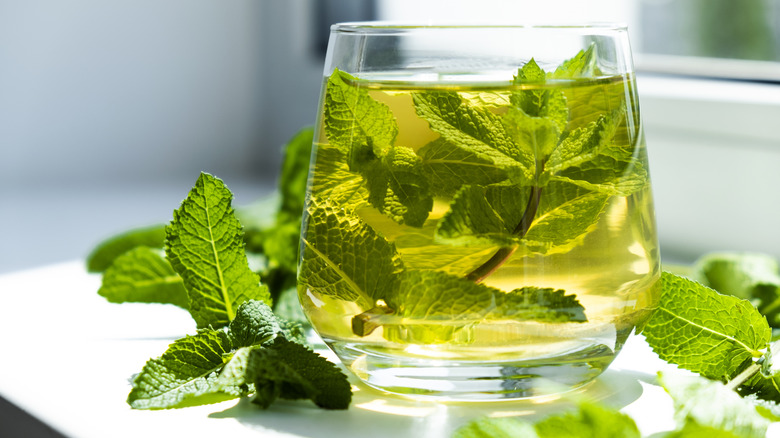What Is Chocolate Mint And How Do You Use It?
For chocoholics the world over, the aroma of chocolate evokes the sweet essence of a traditional candy shop. But getting a fix of the sweet stuff can come at the cost of expanding waistlines and overloads of sugar and fat content. The connoisseur who wants to add a little chocolate touch to every meal is left with an eternal dilemma of whether to up the calorie intake in their recipe of choice.
But did you know that Mother Nature has come up with a remedy? Chocolate mint, an herb that can be grown in any garden, can deliver that same chocolaty scent with an undertone of minty milk cocoa. Even better, chocolate mint is all-natural, and most mint leaves boast minimal calories per serving. Chocolate mint can accentuate any recipe by adding a hint of your favorite confection into the mix. From cookies to coffee and from juleps to beef Jeju, chocolate mint will quickly rise to the top of any cocoa aficionado's secret ingredient list.
What is chocolate mint?
Chocolate mint, you won't be shocked to learn, is a member of the mint family. As its scientific name Mentha × piperita f. citrata implies, chocolate mint is a cross between peppermint and orange mint. The result of this mixed parentage is an herb with stems that are chocolate in color and leaves that give off a whiff of cocoa. It's a sturdy, hardy herb that grows far and fast if left unchecked, turning any garden into a Willy Wonka olfactory extravaganza.
For cooking, perhaps the most important part is that the mint leaves have a chocolatey flavor, with a touch of mint and vanilla added. But here's where taste buds can differ: Some sources say that chocolate mint is named for its color and scent rather than its taste, while others disagree. Is the chocolate in chocolate mint really all in the nose and eyes? Our recommendation is before planting, buy a sample and try it out for yourself.
How does chocolate mint grow?
Chocolate mint is sterile, meaning it doesn't grow from seeds. If you do purchase chocolate mint seeds, your plant might not grow as expected, leaving disappointment in how the resulting herb smells and tastes. Instead, start with a cutting or two from an existing specimen, and transplant it in soil. Or, simply buy a pre-potted chocolate mint at your local nursery.
Whatever strategy you use, make sure that chocolate mint gets plenty of sun — about five to six hours at the least. If starting your own pot, aim for rich soil, and feel free to add compost. Chocolate mint is pretty thirsty year-round, so make sure to keep the soil moist and well-drained to prevent the plant from drowning.
When you're ready to harvest, don't just select the leaves. Break off and take stems in your harvest to keep the leaves from wilting and to prevent overgrowth. The stems can also be bundled for storage so you can refrigerate chocolate mint (or any other herb) for maximum flavor.
How should you prep chocolate mint?
Chocolate mint shares the family name with peppermint and spearmint, but don't just toss mint leaves into a pot. Not all mints should be prepped the same way when you're ready to cook. Some tips you need when cooking with mint include knowing how minty you want your dish. Leaves have the most flavor but if you think your dish might taste like you're biting into a stack of Nestle After Eight wafers, try using the stems for a subtle taste.
When storing chocolate mint, you have two main options: wet and dry. Generally speaking, the absolute best way to keep mint fresh is to use the fridge. Stick the stems into a cup of fresh water, like flowers in a vase, and place them in the back of the fridge for up to three weeks. Conversely, you can freeze the leaves in ice cubes in the freezer. Drying your leaves for long-term storage works too. But remember that most dried herbs pack a stronger pungent punch. You won't need as much chocolate mint when substituting dried herbs for fresh.
Refresh with a cup of mint chocolate tea
If you're angling to try chocolate mint in its purest form, tea is the only recipe that calls for it as the sole ingredient. The simplest way is to rinse off some chocolate mint leaves and stems and crush them by hand. Then, add hot water — the amount of herbal leaves and the water depends on how strong you want your tea. If you're looking to make your chocolate mint tea a little sweeter, add some honey or maple syrup.
Herbal teas, especially mint, have a long and proud history as a home remedy for many aches and ailments. Mint, like other common herbs and their uses, has a strong track record for soothing stomach pains, nausea, and insomnia, per The Alchemist's Kitchen. Peppermint tea in particular, as noted by WebMD, can help the body relax after dinner by easing digestion and helping muscles unwind. But unlike other mint teas, the soothing hint of hot cocoa is more dessert than medicine.
Blend chocolate mint in coffees and shakes
Mint and chocolate are already popular mixers in many coffees and shakes. One downside of chocolate-infused coffees is that the sugar and calorie count can jump off the chart. Fortunately, herbal solutions can satisfy the sweet tooth while keeping the fat and sugar content down.
Iced coffee's flavor can especially pop when fresh herbs are added, and chocolate mint is certainly a worthy contender as an additive. Just hand-crush the chocolate mint leaves and stems or, if using a coffee grinder, add the chocolate mint to the beans for an even distribution. If the chocolate taste is too strong or light, adjust the number of leaves or stems for the next day's brew.
For shakes, the procedure is the same. Add chocolate mint to the other customized ingredients, like vanilla ice cream, in the blender or shake maker, and let the machine do the work. For a fancy touch, add a sprig of chocolate mint atop the whipped cream and cherries.
Concocting chocolate-chocolate-chocolate mint juleps
A mint julep is a Southern staple when kicking back to watch the Kentucky Derby or welcoming in the first breath of spring. The classic mint julep recipe already has plenty of mint to accentuate the booze, but chocolate mint can take this refresher to the next level.
Chocolate has already made headway into many cocktails, so adding chocolate mint to a mint julep is a natural step in a sweet direction. One easy way to intensify the blast of good ol' Southern mint is to supplement stems of fresh chocolate mint to enhance the other standard mint ingredients, like mint syrup and mint garnish. As noted above, the stems have a subtle chocolate flavor, so if you're looking to bump up the chocolate further without making it overly sweet, add in some chocolate bitters or grounded semi-sweet chocolate chips. If you're hankering for a perfect fusion of cocoa and alcohol, a dab of chocolate liquors can really turn this beverage into a dessert all on its own. Dusting the crushed ice with cocoa baking powder or hot chocolate mix will also make this concoction an eye-catching, mouth-watering refresher on a warm afternoon. For the perfect summer-fusion cocktail, try adding a chocolate-covered cherry or a chocolate-dipped strawberry as a topper.
You can mix chocolate mint into pastries, cookies, and cakes
Chocolate is a staple in many baked goods, from cakes to cookies to pastries, and chocolate mint can accentuate the ingredients in nearly all of them. One simple step is to just add the chocolate mint to existing food recipes and box kits. Chocolate mint can dash up box mixes for brownies and cakes in multiple ways, from adding a decorative mint sprig on top to flavoring the chocolate in each bite.
One caveat: As noted above, some testimonies claim that chocolate mint doesn't have a chocolatey taste. If you're using a box mix, the ingredients are already blended and just require a minty touch-up. But if you're starting from scratch, please keep in mind that chocolate mint doesn't have the added sugar and fat that processed cocoa beans have. So if you're planning to substitute chocolate mint as an all-healthy alternative to chocolate chips in cookie batter, your taste buds might be disappointed. Biting into a chocolate mint herbal cookie might not have the same texture and sweet goodness as the real thing.
Whip up chocolate mint extracts and jellies
Crushing herbs is the most common way to bring out its flavor. But for chocolate mint, other techniques can capture its essence through oil extracts. Alcohol is generally used as a base for the strained leaves, and flavorless vodka is a good starting point for keeping the extract pure. If the mint is too overpowering, add chocolate nibs into the extract to make the chocolate flavor stronger. Leave the extract for six to eight weeks before using, and shake or stir the jar daily to ensure even mixing. This extract goes well in baking recipes, as well as in frosting to complement vanilla extract.
Herbal mints can also be made into jellies, and chocolate mint is no exception. If your mint jelly is too pale or the taste is a bit weak, mix in additional mint flavors and dark green food coloring to bring out the mintiness. The jelly will have a predominately minty flavor, so add in sugar to sweeten it to your preferred taste.
Meats can get (chocolate) minty, too
Many herbs go well together, and chocolate mint is no exception. For the daring and the different, try combining chocolate mint with other seasonings for creative rubs. Regular chocolate candies are one ingredient that can add more flavor to beef stew along with thickening the stew's consistency. Chocolate is especially used for lamb chops and sauces. Making a stir fry? Chocolate mint blends well with grounded parsley and peppers to give your dish an extra kick. If you especially love spice, blending chocolate mint with Cajun spices and throwing in a dash of pineapple salsa will make your taste buds sit up and dance.
Whether adding the herb to a sauce or seasoning the meat directly, chocolate mint's subdued flavor can bring out your meats without overpowering their natural tastes. Without any added sugar or fat content, you won't have to worry about sweetening your meat or increasing the saturated fat and cholesterol count. So the next time you're preparing a spice rub, marinade, or sauce, mix in some chocolate mint with the garlic and rosemary.
Taking chocolate mint beyond the kitchen
Chocolate mint can change the way any chef cooks. But chocolate mint can go well beyond the dinner plate as well. Many of your kitchen tools and ingredients do double duty beyond their box instructions, and chocolate mint is no exception.
Kitchen gadgets have been gaining traction as excellent multitasking tools for DIY projects to accentuate the home. Take the simple rice cooker. One of the best uses for your rice cooker is to dry out herbs into homemade potpourri, and a hint of chocolate mint can spice up your home air freshener. Many restaurateurs have also green-lit the hot trend in food-scented candles to build brand value by adding simple scents to complement their signature dishes. For a shop or restaurant that specializes in desserts and sweets, enlisting chocolate mint's aroma can invite those customers who simply follow their nose to hit that sweet spot.










